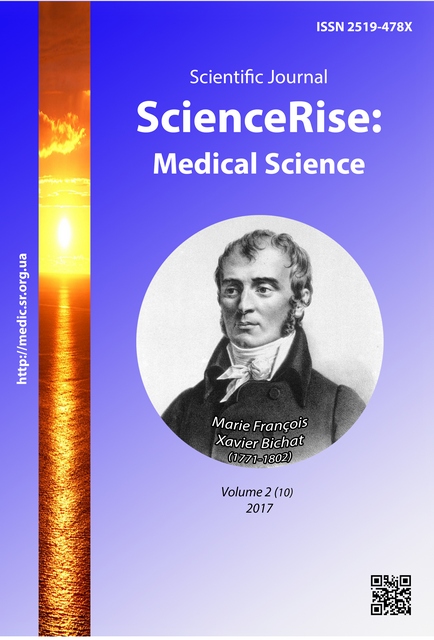Prediction of development of early postoperative complications of the contact ultrasound lithotripsy
DOI:
https://doi.org/10.15587/2519-4798.2017.94123Keywords:
ureterolithiasis, ureteroscopy, contact ureterolithotripsy, ureteral stone density, ureteral stone size, complicationsAbstract
Nowadays, endoscopic treatment of kidney and upper ureter stones is the method of choice in a large group of patients. The success of ureteroscopic treatment of stones is a result of the development of efficient flexible ureteroscopes, new capture devices and laser lithotripters.
Aim. The analysis of the reasons and the character of early postoperative complications after ureteroscopy and contact lithotripsy using semi-rigid ureteroscope and ultrasonic lithotripter.
Methods. Ureteroscopy with contact lithotripsy and (or) lithoextraction against concrements of various ureter departments was made in 1268 patients. The patients were monitored after discharge in dynamics from 8 weeks to 1.5 years, and on the testimony - until the elimination of complications. All complications were divided in accordance with their severity degree by Satava classification.
Results. 179 patients with early postoperation complications were found. In 62 (34.6%) hyperthermia, in 56 (31.3%) - persistent hematuria, and in 61 (34.1%) – renal colic were detected.
Conclusion. In 60% of patients with 1 cm stones and 50% of patients with stones up to 1.5 cm early postoperative complications were found when the stone density was more than 1500 HU. When the stone size was 1.5 cm or more, the complications were found regardless of its density. When the stone size was less then 1 cm, early postoperative complications in the main were found at concrement’s localization in upper ureter (59.5 % of the patients). In patients with the stone density more than 1500 HU the highest number of complications was detected at the stones’ localization in upper and lower ureter – 14 (37.8%) and 16 (43.2%) cases, respectively
References
- Borzhijevs'kyj, A. C., Sheremeta, R. Z., Zhuravchak, A. Z., Borzhijevs'kyj, O. A. (2003). Antegradna ureterolitotrypsija kameniv proksymal'nogo viddilu sechovodu. Praktychna medycyna, 9 (1), 63–66.
- Vozianov, S. O., Borzhijevs'kyj, A. C. (2004). Porivnjal'na harakterystyka riznyh metodiv endoskopichnoi' ureterolitotrypsii'. Zhurnal Nacional'noi' akademii' medychnyh nauk Ukrai'ny, 10 (1), 91–103.
- Bapat, S. S., Pai, K. V., Purnapatre, S. S., Yadav, P. B., Padye, A. S. (2007). Comparison of Holmium Laser and Pneumatic Lithotripsy in Managing Upper-Ureteral Stones. Journal of Endourology, 21 (12), 1425–1428. doi: 10.1089/end.2006.0350
- Hollenbeck, B. K., Schuster, T. G., Faerber, G. J., Wolf, J. S. (2001). Comparison of outcomes of ureteroscopy for ureteral calculi located above and below the pelvic brim. Urology, 58 (3), 351–355. doi: 10.1016/s0090-4295(01)01266-3
- Hollenbeck, B. K., Schuster, T. G., Seifman, B. D., Faerber, G. J., Wolf, J. S. (2003). Identifying patients who are suitable for stentless ureteroscopy following treatment of urolithiasis. The Journal of Urology, 170 (1), 103–106. doi: 10.1097/01.ju.0000069546.53896.6a
- Hollenbeck, B. K., Schuster, T. G., Faerber, G. J., Wolf, J. S. (2001). Routine placement of ureteral stents is unnecessary after ureteroscopy for urinary calculi. Urology, 57 (4), 639–643. doi: 10.1016/s0090-4295(01)00917-7
- Panin, A. G., Stecik, O. V., Cjendin, A. K. (2002). Ocenka lazernoj kontaktnoj litotripsii v lechenii bol'nyh s kamnjami mochetochnikov. Moscow, 768–769.
- Sernjak, Ju. P., Roshhin, Ju. V. (2005). Sovremennye metodologicheskie podhody k lecheniju kamnej mochetochnika. Arhiv klinicheskoj i jeksperimental'noj mediciny, 14 (1), 117–120.
- Byrne, R. R., Auge, B. K., Kourambas, J., Munver, R., Delvecchio, F., Preminger, G. M. (2002). Routine Ureteral Stenting is Not Necessary After Ureteroscopy and Ureteropyeloscopy: A Randomized Trial. Journal of Endourology, 16 (1), 9–13. doi: 10.1089/089277902753483646
- Chow, G. K., Patterson, D. E., Blute, M. L., Segura, J. W. (2003). Ureteroscopy: Effect of Technology and Technique on Clinical Practice. The Journal of Urology, 170 (1), 99–102. doi: 10.1097/01.ju.0000070883.44091.24
- Geavlete, P., Georgescu, D., Nita, Gh., Mirciulescu, V., Cauni, V., Aghamiri, S. (2004). Complications after 2.272 retrograde ureteroscopies: A single-center experience. BJU International, 94, 278.
- Johnson, D. B., Pearle, M. S. (2004). Complications of ureteroscopy. Urologic Clinics of North America, 31 (1), 157–171. doi: 10.1016/s0094-0143(03)00089-2
- Antonjan, I. M., Stecishin, R. V., Roshhin, Ju. V. (2016). The analysis of late postoperative complications after treatment of ureteral stones using ureteroscopy and contact ultrasonic lithotripsy. ScienceRise: Medical Science, 12 (8), 63–72. doi: 10.15587/2519-4798.2016.87890
- Ziaee, S. A. M., Halimi, M. R., Aminsharifi, A., Shafi, H., Basiri, A. (2007). Management of 10–15 mm proximal ureteral stones: ureteroscopy or ESWL, a prospective patient preference trial. Urology, 70 (3), 220–241. doi: 10.1016/j.urology.2007.06.801
- Chang, C.-P., Huang, S.-H., Tai, H.-L., Wang, B.-F., Yen, M.-Y., Huang, K.-H. et. al. (2001). Optimal Treatment for Distal Ureteral Calculi: Extracorporeal Shockwave Lithotripsy versus Ureteroscopy. Journal of Endourology, 15 (6), 563–566. doi: 10.1089/089277901750426292
- Glybochko, P. V., Aljaev, Ju. G., Rapoport, L. M., Carichenko, D. G., Aksenov, A. V. (2011). Oslozhnenija kontaktnoj ureterolitotripsii. Saratovskij nauchno-medicinskij zhurnal, 7 (S2), S139.
Downloads
Published
How to Cite
Issue
Section
License
Copyright (c) 2017 Roman Stetsyshyn

This work is licensed under a Creative Commons Attribution 4.0 International License.
Our journal abides by the Creative Commons CC BY copyright rights and permissions for open access journals.
Authors, who are published in this journal, agree to the following conditions:
1. The authors reserve the right to authorship of the work and pass the first publication right of this work to the journal under the terms of a Creative Commons CC BY, which allows others to freely distribute the published research with the obligatory reference to the authors of the original work and the first publication of the work in this journal.
2. The authors have the right to conclude separate supplement agreements that relate to non-exclusive work distribution in the form in which it has been published by the journal (for example, to upload the work to the online storage of the journal or publish it as part of a monograph), provided that the reference to the first publication of the work in this journal is included.









